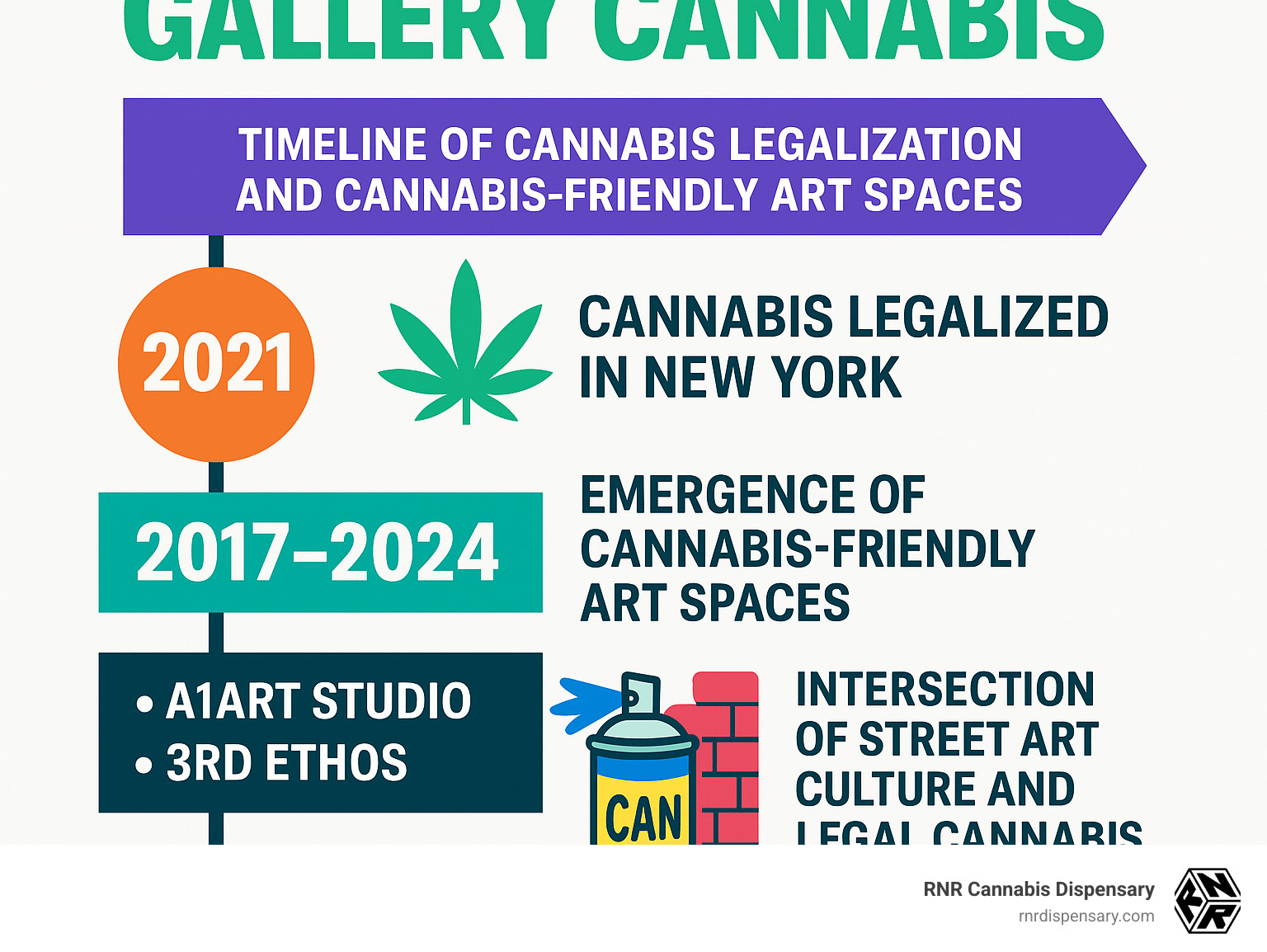Why Bushwick Art Gallery Cannabis is Changing Brooklyn’s Creative Scene
Bushwick Art Gallery Cannabis represents a groundbreaking fusion where street art meets legal cannabis culture in one of Brooklyn’s most creative neighborhoods. This movement combines traditional gallery spaces with cannabis-friendly environments, creating unique experiences for artists and art lovers alike.
Key Cannabis Art Spaces in Bushwick:
– A1Art Studio – Latina-owned space hosting weekend “puff, paint & sip” classes
– 3rd Ethos Gallery – 5+ year veteran showcasing early-to-mid career artists with cannabis-friendly events
– Skewville – 25-year-old street art gallery operating from a colorful townhouse garage
– Lucas Lucas (formerly) – Pioneered cannabis equity discussions through art programming
The legal landscape shifted dramatically after New York’s cannabis decriminalization in 2021. The Office of Cannabis Management clarified that murals and artwork outside dispensaries are legal as long as they don’t advertise cannabis or target minors – a ruling that came after community backlash when the iconic Biggie Smalls mural in Bushwick was temporarily covered by a new dispensary.
Artists like Killer Acid have openly discussed how cannabis improves their creative process, particularly during the sketching phase. As one Brooklyn illustrator put it: “I don’t do drugs recreationally anymore. I just smoke weed and work.”
These spaces serve as what sociologist Ray Oldenburg calls “third places” – community hubs beyond home and work where ideas are exchanged and relationships built. They’re changing how we think about both cannabis consumption and art appreciation.
I’m Ronald Shen, founder of RNR Cannabis Dispensary in Bushwick, where we’ve partnered with local artists to create rotating art exhibits that blend cannabis and creative culture. My experience as a CAURD-approved license applicant has given me insight into how Bushwick Art Gallery Cannabis spaces steer regulations while fostering genuine community connections.

Bushwick Art Gallery Cannabis: How Did We Get Here?
The story of Bushwick Art Gallery Cannabis didn’t start with legalization – it began decades ago when artists first picked up spray cans and transformed abandoned factory walls into vibrant masterpieces. Street art has always been Bushwick’s creative heartbeat, turning forgotten corners into outdoor galleries that rival any museum.
When New York finally legalized recreational cannabis in 2021, something beautiful happened. These existing creative spaces naturally acceptd the plant’s role in artistic culture. It wasn’t a forced marriage – it was more like two old friends finally getting to hang out in public.
But the path wasn’t smooth. The Office of Cannabis Management had to figure out new rules while neighborhoods worried about losing their cultural identity. The most dramatic example? The beloved Biggie Smalls mural by street artist Huetek got temporarily covered when a new dispensary opened nearby.
The community wasn’t having it. Residents flooded Reddit and local news outlets, treating the mural’s covering like a cultural emergency. And honestly? They were right to be upset. That mural had survived three years without a single tag – a testament to how much the neighborhood respected it.
This controversy actually helped clarify the rules. The OCM explained that artwork outside dispensaries is perfectly legal as long as it doesn’t advertise cannabis products or target minors. The mural was restored at a public celebration, proving that community voices matter in shaping how Bushwick Art Gallery Cannabis culture develops.
Take Skewville as a perfect example of this evolution. Operating from a colorful townhouse garage with no exterior signage, the brothers behind this space have been creating art for 25 years. Their worldwide sneaker sculpture project represents the DIY spirit that makes Bushwick’s cannabis art scene so authentic – it’s community-driven, not corporate-imposed.
Scientific research on creativity & cannabis backs up what artists have known forever: cannabis can boost creative thinking, especially during brainstorming. This research has helped move cannabis use in artistic settings from counterculture to accepted practice.
The Rise of Street Aesthetics to Gallery Respectability
Watching street art gain mainstream respect is like watching cannabis shed its stigma – both journeys mirror each other perfectly. What started as underground rebellion has become gallery-worthy art commanding serious prices and museum attention.
Skewville’s founders, Ad and Droo, left their advertising careers specifically to avoid corporate gatekeeping. Their 25-year sneaker project has resulted in thousands of plywood sculptures hanging on telephone lines across dozens of cities worldwide. This independent approach resonates throughout Bushwick’s entire art ecosystem.
Early galleries like Factory Fresh took risks on street artists when traditional spaces wouldn’t touch them. They paved the way for today’s Bushwick Art Gallery Cannabis scene by proving that authentic art doesn’t need establishment approval to find its audience.
The Biggie mural saga perfectly captures this tension between street credibility and commercial interests. When the mural was temporarily covered, locals didn’t just see lost art – they saw their neighborhood identity being erased for business concerns. The swift community response showed that Bushwick residents are fierce protectors of their cultural landmarks.


